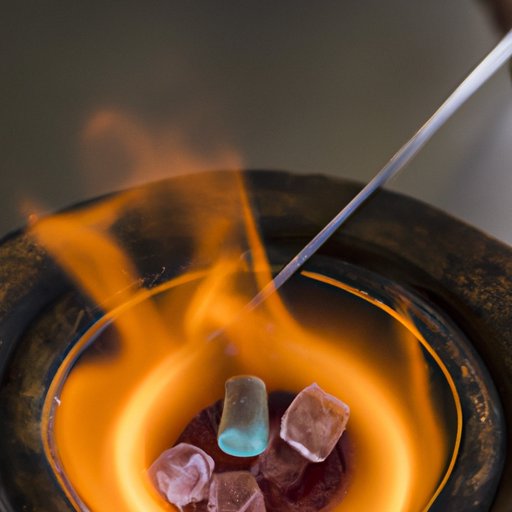
I. Introduction
Caramelizing sugar is a technique that elevates desserts to new heights. While it may seem intimidating, caramelizing sugar can be mastered with practice and patience. This article will guide you through the steps of caramelizing sugar, explain the benefits of doing so, and provide unique ways to experiment with the technique.
II. Mastering the Art of Caramelizing Sugar: A Step-by-Step Guide
Caramelizing sugar involves heating sugar to a high temperature until it melts and turns into a golden-brown liquid. This liquid is what gives desserts a rich, caramelized flavor. The key ingredients in the process are sugar and water. The ratio of sugar to water will vary depending on the recipe and desired consistency. Usually, a ratio of 2:1 sugar to water is used for a thick syrup consistency.
To begin the process, add the sugar and water to a heavy-bottomed saucepan. Turn the heat to medium-high and stir occasionally until the sugar dissolves. Once the sugar has dissolved, turn up the heat to high and stop stirring. Allow the mixture to boil and the water to evaporate until it becomes a deep amber color.
It’s important to monitor the color and temperature of the sugar as it caramelizes. Use a candy thermometer to ensure it reaches the desired temperature. It’s recommended to remove the sugar from the heat just before it reaches the desired temperature since it will continue to cook and darken as it cools.
Once the desired color and temperature are reached, remove the sugar from the heat and add any additional ingredients, such as cream or butter, while stirring constantly. Be careful since the sugar mixture is extremely hot and can splatter.
A common mistake many people make is stirring the sugar too much. This can cause the sugar to crystallize or clump, resulting in an unappetizing texture. Another mistake is to let the sugar darken too much, resulting in a burnt flavor.
III. Why Caramelizing Sugar is the Secret to Elevating Your Desserts
Caramelizing sugar adds depth and complexity to desserts. When sugar is heated to a high temperature, it undergoes the Maillard reaction, which causes it to release hundreds of flavor compounds. The resulting flavor is rich, nutty, and sweet with a hint of bitterness.
Desserts that rely on caramelized sugar to shine include crème brûlée, flan, tarte tatin, and caramel sauce. Without the caramelized sugar, these desserts would be lacking in flavor and texture.
IV. Experimenting with Flavor: 5 Creative Ways to Caramelize Sugar
Caramelized sugar can be made using various types of sugar, each with their distinct flavor and texture. White granulated sugar will produce a classic caramel flavor, while brown sugar will result in a more molasses-like flavor.
Some unique types of sugar to try include muscovado, coconut sugar, and palm sugar. Each of these sugars has a unique flavor profile that can add depth and complexity to caramelized sugar.
Incorporating spices or herbs, such as cinnamon or rosemary, can add a new layer of flavor to caramelized sugar. You can also experiment with combining different types of sugar or adding extracts like vanilla or almond.
V. Caramelizing Sugar 101: Tips and Tricks for Perfecting the Technique
While caramelizing sugar is a straightforward process, there are some common issues that can arise. One of the most common issues is crystallization, which happens when sugar crystals form in the mixture. This can be prevented by adding a bit of acid, like lemon juice, to the sugar mixture before heating.
It’s important to stay vigilant when caramelizing sugar as it can burn quickly. Adjusting the heat and cooking time based on the recipe can help ensure the sugar doesn’t overcook. A darker color can equal a more complex flavor, but it’s important not to let the sugar darken too much as it can result in a burnt flavor.
VI. Fall in Love with Caramelized Sugar: Variations and Uses
Caramelized sugar can be used in various forms, such as a syrup, sauce, or candy. Caramelized sugar syrup can be added to coffee or cocktails to add sweetness and flavor. Caramelized sugar sauce is perfect for drizzling over ice cream or fruit. Caramelized sugar candy is great for snacking or for use in other recipes.
Some suggestions for desserts that incorporate caramelized sugar include macarons, cheesecake, and bread pudding. Caramelized sugar can complement many different flavor profiles, from fruity to savory.
VII. Get Creative in the Kitchen: 3 Unique Ways to Caramelize Sugar
Burnt honey ice cream is a unique recipe that uses caramelized honey instead of sugar to add a complex, nutty flavor to the ice cream. Caramelized white chocolate involves caramelizing the sugar in white chocolate to create a caramel flavor that pairs perfectly with dark chocolate and fruit. Adding caramelized sugar to whipped cream creates a delicious topping for pies and cakes.

VIII. From Crème Brûlée to Tarte Tatin: How to Caramelize Sugar for Your Favorite Desserts
Caramelizing sugar for different desserts can require different techniques. For crème brûlée, the sugar is sprinkled over the custard and then torched. For tarte tatin, apples are cooked in caramelized sugar in a cast-iron skillet before being baked with pastry on top. A caramel sauce is made by adding cream and butter to caramelized sugar and can be used as a topping for ice cream or cheesecake.
IX. Conclusion
Caramelizing sugar is a simple technique that can elevate desserts to new heights. With practice, anyone can master the art of caramelizing sugar.




